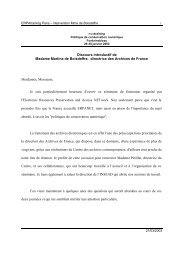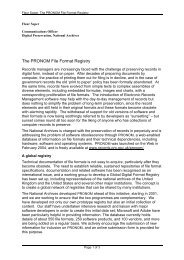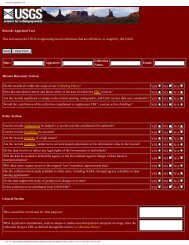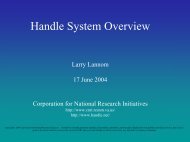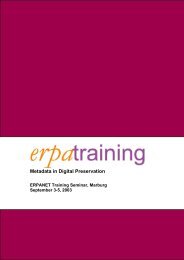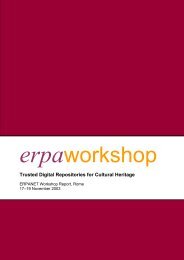An Introduction to ERPANET
An Introduction to ERPANET
An Introduction to ERPANET
- No tags were found...
Create successful ePaper yourself
Turn your PDF publications into a flip-book with our unique Google optimized e-Paper software.
<strong>ERPANET</strong>, SA Presentation on Reposi<strong>to</strong>ries, 30 August 2004 (Glasgow)<strong>ERPANET</strong>@SAA2004:Trusted Reposi<strong>to</strong>riesSA Pre-Conference Workshop30 August 2004, GlasgowSeamus Ross<strong>ERPANET</strong><strong>ERPANET</strong> & HATII -- Seamus Ross: Trusted Digital Reposi<strong>to</strong>ries 1
<strong>ERPANET</strong>, SA Presentation on Reposi<strong>to</strong>ries, 30 August 2004 (Glasgow)Presentation based on<strong>ERPANET</strong>’s Rome WorkshopSee Rome presentations at:http://www.erpanet.org<strong>ERPANET</strong> & HATII -- Seamus Ross: Trusted Digital Reposi<strong>to</strong>ries 2
<strong>ERPANET</strong>, SA Presentation on Reposi<strong>to</strong>ries, 30 August 2004 (Glasgow)Digital Preservation Requires• What are the features of a ‘trusted digital reposi<strong>to</strong>ry’?• What current implementations may be rightfully called “trusted digital reposi<strong>to</strong>ries”?• How are the concepts of reliability, authenticity and trustworthiness interpreted indifferent contexts and why?• How should the roles and responsibilities of the many stakeholders be addressed?• Is the potential of trusted digital reposi<strong>to</strong>ries currently being adequately exploited?• What issues have not yet been addressed in trusted digital reposi<strong>to</strong>riesimplementations and research?• Is it possible and/or necessary <strong>to</strong> agree on one definition of trusted digitalreposi<strong>to</strong>ry?• How do different communities see trusted digital reposi<strong>to</strong>ries?• Creating and maintaining the trust of their user communities overtime and in theface of changing technologies.<strong>ERPANET</strong> & HATII -- Seamus Ross: Trusted Digital Reposi<strong>to</strong>ries 3
<strong>ERPANET</strong>, SA Presentation on Reposi<strong>to</strong>ries, 30 August 2004 (Glasgow)Preservation Models: OAIS• OAIS = Open Archival Information Systems• Key players in development– National Space Science Data Centre– Consultative Committee for Space Data Systems• Now an ISO Standard•Premises Underlying OAIS–Data are irreplaceable (esp observation)–Data and associated metadata must be moved acrosstechnologies– Representations and formats will change– Lack of consensus on adequate metadata standards<strong>ERPANET</strong> & HATII -- Seamus Ross: Trusted Digital Reposi<strong>to</strong>ries 4
<strong>ERPANET</strong>, SA Presentation on Reposi<strong>to</strong>ries, 30 August 2004 (Glasgow)Key OAIS Objectives•Objective–recognised no framework for developing digital archivestandards–need for a reference model–recognise the hybrid nature of archives– collaborate with archival community–focus on data resulting from space missions–near‐term and indefinite s<strong>to</strong>rage of digital data–independent of implementation model– address full range of archival processes<strong>ERPANET</strong> & HATII -- Seamus Ross: Trusted Digital Reposi<strong>to</strong>ries 5
<strong>ERPANET</strong>, SA Presentation on Reposi<strong>to</strong>ries, 30 August 2004 (Glasgow)Process of Development•Examine other models•Define Data Archiving•Define functional areas (FAs) includingingest, s<strong>to</strong>rage, access, and preservation•Define interfaces between FAs•Define a set of data classes•Formal representation methods<strong>ERPANET</strong> & HATII -- Seamus Ross: Trusted Digital Reposi<strong>to</strong>ries 6
<strong>ERPANET</strong>, SA Presentation on Reposi<strong>to</strong>ries, 30 August 2004 (Glasgow)OAIS Overview•Manages ingest of Information Packages fromcrea<strong>to</strong>rs• Defines the communities needing theInformation•Reflects needs of identified user community•Enables preservation in an understandableway•Uses documented policies and procedures<strong>ERPANET</strong> & HATII -- Seamus Ross: Trusted Digital Reposi<strong>to</strong>ries 7
<strong>ERPANET</strong>, SA Presentation on Reposi<strong>to</strong>ries, 30 August 2004 (Glasgow)Advantages of OAIS•Provides a model where one was lacking• Facilitates procurement of systems•Enables interoperability between OAIScomplaint systems•Supports the migration task•Lays out a minimum set of responsibilities<strong>ERPANET</strong> & HATII -- Seamus Ross: Trusted Digital Reposi<strong>to</strong>ries 8
<strong>ERPANET</strong>, SA Presentation on Reposi<strong>to</strong>ries, 30 August 2004 (Glasgow)What does it support?•Resource Information about objects– Submission Information Package–Archival Information Package–Dissemination Information Package• Relates activities of producer, manager andconsumer•Supports Functional Entities<strong>ERPANET</strong> & HATII -- Seamus Ross: Trusted Digital Reposi<strong>to</strong>ries 9
<strong>ERPANET</strong>, SA Presentation on Reposi<strong>to</strong>ries, 30 August 2004 (Glasgow)OAIS Functional Entities•Ingest•Archival S<strong>to</strong>rage•Data Management• Administration• Preservation Planning•Access<strong>ERPANET</strong> & HATII -- Seamus Ross: Trusted Digital Reposi<strong>to</strong>ries 10
<strong>ERPANET</strong>, SA Presentation on Reposi<strong>to</strong>ries, 30 August 2004 (Glasgow)OAIS Functional Entities<strong>ERPANET</strong> & HATII -- Seamus Ross: Trusted Digital Reposi<strong>to</strong>ries 11
<strong>ERPANET</strong>, SA Presentation on Reposi<strong>to</strong>ries, 30 August 2004 (Glasgow)•Archive & Library CommunityWho is working with OAIS– Koninklijke Bibliotheek (KB) through NEDLIB—designand architecture of Deposit System for Electronicpublications– CEDARS–NARA and the San Diego SuperComputer Center–National Space Science Data Center– Pharmaceutical & Aerospace Industries–French Space Agency for its plasma physics archive<strong>ERPANET</strong> & HATII -- Seamus Ross: Trusted Digital Reposi<strong>to</strong>ries 12
<strong>ERPANET</strong>, SA Presentation on Reposi<strong>to</strong>ries, 30 August 2004 (Glasgow)What must a Reposi<strong>to</strong>ry Do•Handle a wide array of digital media types•Be Secure•Guarantee authenticity of the objects it holds•Protect Integrity (from intended and untended harm)•Enable verification• Ensure stuff ingested in<strong>to</strong> the archive can be output(e.g. be accessible)•Self‐contained (in operation)–Must not rely on external infrastructure or services– Maintain all documentation in‐house– Have disaster recovery functionality built‐in<strong>ERPANET</strong> & HATII -- Seamus Ross: Trusted Digital Reposi<strong>to</strong>ries 13
<strong>ERPANET</strong>, SA Presentation on Reposi<strong>to</strong>ries, 30 August 2004 (Glasgow)Reposi<strong>to</strong>ries must be trusted•Processes:–Workflows–Operation (management of integrity, authenticity,intelligibility, and accessibility– Au<strong>to</strong>mation (e.g. ingest, management,publication)– Documentation of procedures– Auditability•Architecture and Implementation<strong>ERPANET</strong> & HATII -- Seamus Ross: Trusted Digital Reposi<strong>to</strong>ries 14
<strong>ERPANET</strong>, SA Presentation on Reposi<strong>to</strong>ries, 30 August 2004 (Glasgow)Flexible Technical Infrastructure• Hardware and software elements must be–Sustainable• Financially•Reasonable levels of complexity• Management–Open•Modular (flexibility <strong>to</strong> dump obsolete HW and SW)• Migratable (possibility <strong>to</strong> change <strong>to</strong> HW and SW)–Secure (no unauthorized access)– Reliable (no data loss)– Available (the data is at hand when you need it)<strong>ERPANET</strong> & HATII -- Seamus Ross: Trusted Digital Reposi<strong>to</strong>ries 15
<strong>ERPANET</strong>, SA Presentation on Reposi<strong>to</strong>ries, 30 August 2004 (Glasgow)Authenticity•Requires control of ingest and its verification•Depends on immutability of the data s<strong>to</strong>re•Migration may destroy original byte stream– archives and stakeholders must identify significantproperties and validate their migration• Support Audit of the chain of cus<strong>to</strong>dy, processhis<strong>to</strong>ry, and the descriptions of the migrationprocesses•Provide mechanisms <strong>to</strong> enable use (including access<strong>to</strong> context information and rendering)<strong>ERPANET</strong> & HATII -- Seamus Ross: Trusted Digital Reposi<strong>to</strong>ries 16
<strong>ERPANET</strong>, SA Presentation on Reposi<strong>to</strong>ries, 30 August 2004 (Glasgow)Reposi<strong>to</strong>ry Operation• Change will be a feature of reposi<strong>to</strong>ries– S<strong>to</strong>rage technologies–Services, close down of some and initiation ofothers–Workflows– Verification mechanisms–Migration, refreshing, emulation<strong>ERPANET</strong> & HATII -- Seamus Ross: Trusted Digital Reposi<strong>to</strong>ries 17
<strong>ERPANET</strong>, SA Presentation on Reposi<strong>to</strong>ries, 30 August 2004 (Glasgow)Au<strong>to</strong>mation•Huge quantities of materials <strong>to</strong> ingest and manage• Au<strong>to</strong>mation of workflows allow integration ofindependent services• Standardized logging/record creation•Reduce human intervention–Cheaper–Less error prone–Enables higher level of security and reliability• Intensive test and verification needed–Mistakes are very costly (financially but moreimportantly in terms of trust<strong>ERPANET</strong> & HATII -- Seamus Ross: Trusted Digital Reposi<strong>to</strong>ries 18
<strong>ERPANET</strong>, SA Presentation on Reposi<strong>to</strong>ries, 30 August 2004 (Glasgow)Media Vault (ARKive)<strong>ERPANET</strong> & HATII -- Seamus Ross: Trusted Digital Reposi<strong>to</strong>ries 19
<strong>ERPANET</strong>, SA Presentation on Reposi<strong>to</strong>ries, 30 August 2004 (Glasgow)National Archives of Australia• NAA follows OAIS Framework• Uses an open source‐based solution• Focuses on use of xml• Uses open and well‐documented data formats• Not creating a digital archive, but a preservationapproach• Need <strong>to</strong> address: appraisal/selection, transfer,description, and retrieval and access<strong>ERPANET</strong> & HATII -- Seamus Ross: Trusted Digital Reposi<strong>to</strong>ries 20
<strong>ERPANET</strong>, SA Presentation on Reposi<strong>to</strong>ries, 30 August 2004 (Glasgow)Preservation System•3 separate components1. Quarantine2. Preservation3. S<strong>to</strong>rage•All components physically separated fromeach other and all other NAA networks•Access <strong>to</strong> hardware restricted <strong>to</strong> digitalpreservation staffThanks <strong>to</strong> <strong>An</strong>drew Wilson of NAA © for this slide.<strong>ERPANET</strong> & HATII -- Seamus Ross: Trusted Digital Reposi<strong>to</strong>ries 21
<strong>ERPANET</strong>, SA Presentation on Reposi<strong>to</strong>ries, 30 August 2004 (Glasgow)National Library of New Zealand: Proposed Digital Reposi<strong>to</strong>ry StructurePackagedObjectsWebHarvestingUnpublishedDigital MaterialsTemporaryIngestS<strong>to</strong>ragePreservationManagementFacilityNLNZOPACLocal/RemoteInformationConsumersProducts ofDigitisationAccessS<strong>to</strong>rageServicesDigitalReposi<strong>to</strong>ryRoss, 2003: NLNZ Review Document.<strong>ERPANET</strong> & HATII -- Seamus Ross: Trusted Digital Reposi<strong>to</strong>ries 22
<strong>ERPANET</strong>, SA Presentation on Reposi<strong>to</strong>ries, 30 August 2004 (Glasgow)Quarantine serverRecords Transferwritten <strong>to</strong> server• Checksumsverified• Objects undergovirus checkChecked objectswritten <strong>to</strong> transportmediumDPrDigital Preservationrecorder capturesinformation aboutactions on each digitalobjectThanks <strong>to</strong> <strong>An</strong>drew Wilson of NAA © for this slide.• Transportmedium s<strong>to</strong>redon reposi<strong>to</strong>ryshelf for at least4 weeks• Objects then recheckedforviruses usingnew virusdefinitionsFor the technically minded:- Dell PowerEdge 2600 server- 2 x 2GHz processors<strong>ERPANET</strong> & HATII -- Seamus Ross: Trusted Digital Reposi<strong>to</strong>ries - .7Tb disk s<strong>to</strong>re23- independent UPS
<strong>ERPANET</strong>, SA Presentation on Reposi<strong>to</strong>ries, 30 August 2004 (Glasgow)Preservation serverTransport mediumis attached <strong>to</strong>preservation serverPreservationsoftware platform(Xena) processesdigital objectsXena outputs twonew objects andcalculates newchecksums foreach:1.Wrappedbitstream2.‘Normalisedversion’Output setswritten <strong>to</strong> newtransport mediaDPrDigital Preservationrecorder capturesinformation aboutactions on each digitalobjectFor the technically minded:- Dell PowerEdge 2600 server- 2 x 2GHz processorsThanks <strong>to</strong> <strong>An</strong>drew Wilson of NAA © for this slide.<strong>ERPANET</strong> & HATII -- Seamus Ross: Trusted Digital Reposi<strong>to</strong>ries - .7Tb disk s<strong>to</strong>re24- independent UPS
<strong>ERPANET</strong>, SA Presentation on Reposi<strong>to</strong>ries, 30 August 2004 (Glasgow)Digital Reposi<strong>to</strong>ryTransport mediaare attached <strong>to</strong>reposi<strong>to</strong>ry serverSimple managementapplication <strong>to</strong> allowaccess <strong>to</strong> digitalobjects(eg. DSpace)Third copyon digitaltape whichis s<strong>to</strong>redoffsiteDigital Preservationrecorder capturesinformation aboutactions on eachdigital objectDPrRAID S<strong>to</strong>rageCopieswritten <strong>to</strong>new mediafor accessTo AccessFor the technically minded:- Dell PowerEdge 2600 server- 2 x 2GHz processors- .7Tb disk s<strong>to</strong>re- fibre channel betweenserver and RAID- independent UPSRAID S<strong>to</strong>rage2 copies on RAID s<strong>to</strong>rage- Configured as RAID 10- Au<strong>to</strong>mated, regular,frequent verification ofchecksumsThanks <strong>to</strong> <strong>An</strong>drew Wilson of NAA © for this slide.<strong>ERPANET</strong> & HATII -- Seamus Ross: Trusted Digital Reposi<strong>to</strong>ries 25
<strong>ERPANET</strong>, SA Presentation on Reposi<strong>to</strong>ries, 30 August 2004 (Glasgow)ARELDAArchiving of Electronic Digital Data and Records•Goal: Finding long‐term solutions for thepermanent archiving of digital records in the SwissFederal Archives• Indispensable for the long‐term execution of theFederal Archives Act• Development costs 2001 – 2008: ~ 11 Mio €•Operational costs from 2005: 2.5 –3.3 Mio € per year(expected growth: 20 TB/yr net)•Today’s project team: 7 people (4 CS engineers)Thanks <strong>to</strong> Stefan Heuscher of Swiss Federal Archives © for this slide.<strong>ERPANET</strong> & HATII -- Seamus Ross: Trusted Digital Reposi<strong>to</strong>ries 26
<strong>ERPANET</strong>, SA Presentation on Reposi<strong>to</strong>ries, 30 August 2004 (Glasgow)NARA’s Strategic Response –ERA Requirements• Persistent– To manage and access the records over time.• Authentic– To ensure that these are the original records– Records that are created with attached documentaryinformation• Scalable– To grow and adapt <strong>to</strong> increasing volumes and evolvingtypes of electronic records– To serve a variety of user groups (e.g. rich service layer)Thanks <strong>to</strong> Fynnette Ea<strong>to</strong>n of NARA © for this slide.<strong>ERPANET</strong> & HATII -- Seamus Ross: Trusted Digital Reposi<strong>to</strong>ries 27
<strong>ERPANET</strong>, SA Presentation on Reposi<strong>to</strong>ries, 30 August 2004 (Glasgow)Technical Challenges of ERA‣ Receives, s<strong>to</strong>res, preserves, and provides access <strong>to</strong> electronicrecords, regardless of type, format or media.‣ Receives, preserves, and s<strong>to</strong>re electronic records in amanner and environment appropriate <strong>to</strong> their sensitivitylevel.‣ S<strong>to</strong>res electronic records in a manner that allows formaximum possible independence from specific hardwareand software infrastructures.‣ Supports high availability.‣ Provides viable long‐term s<strong>to</strong>rage for electronic records.Thanks <strong>to</strong> Fynnette Ea<strong>to</strong>n of NARA © for this slide.<strong>ERPANET</strong> & HATII -- Seamus Ross: Trusted Digital Reposi<strong>to</strong>ries 28
<strong>ERPANET</strong>, SA Presentation on Reposi<strong>to</strong>ries, 30 August 2004 (Glasgow)NARA argues: reposi<strong>to</strong>ries must‣ Find records based on searches of descriptions of records‣ Search the electronic records themselves.‣ Accurately reproduce and output electronic records.‣ Provide certified copies of electronic records.‣ Manage requests for review of restricted materials.‣ Implement the results of electronic records reviews.‣ Enable users <strong>to</strong> request and receive assistance from archivistsor librarians.Thanks <strong>to</strong> Fynnette Ea<strong>to</strong>n of NARA © for this slide.<strong>ERPANET</strong> & HATII -- Seamus Ross: Trusted Digital Reposi<strong>to</strong>ries 29
<strong>ERPANET</strong>, SA Presentation on Reposi<strong>to</strong>ries, 30 August 2004 (Glasgow)Are there <strong>to</strong>ols• LOCKSS (Lots of Copies Keep Stuff Safe)http://lockss.stanford.edu• Fedora --FEDORA (Flexible and ExtensibleDigital Object and Reposi<strong>to</strong>ry Architecture)http://www.fedora.info/• DSPACE--http://dspace.org/index.html• Digital Asset Management Systems ???<strong>ERPANET</strong> & HATII -- Seamus Ross: Trusted Digital Reposi<strong>to</strong>ries 30
<strong>ERPANET</strong>, SA Presentation on Reposi<strong>to</strong>ries, 30 August 2004 (Glasgow)Digital Asset ManagementSystems (1)• What new opportunities will a DAM system enable the institution <strong>to</strong> create?How will the institution measure whether or not DAM has achieved theobjectives?• What functions of DAM systems are particularly well suited <strong>to</strong> the needs of theinstitution?• How can the institution ensure staff buy‐in <strong>to</strong> DAM technology?• What will be the cost‐benefit ratio?• Which DAMS technologies best fit the institutions requirements? How will theselection process be documented?• Has the institution established that the target DAM system can be optimised forthe data types which the organisation handles, that it supports adequate userprofiling and that the metadata categories supported are adequate?• What impact will the introduction of a DAM solution have on organisationalthinking about and use of digital content?<strong>ERPANET</strong> & HATII -- Seamus Ross: Trusted Digital Reposi<strong>to</strong>ries 31
<strong>ERPANET</strong>, SA Presentation on Reposi<strong>to</strong>ries, 30 August 2004 (Glasgow)DAMS/CMS (2)• What might the implications be in collaborating with other institutions <strong>to</strong> sharea DAMS?• What obstacles might be encountered when attempting <strong>to</strong> introduce DAMtechnology? How can these be overcome?• What metadata are required <strong>to</strong> support the institution’s application of DAMtechnology? How will the metadata be acquired and implemented?• DAMS are based on a combination of technologies and methods, includingsoftware applications and policies and procedures. Have those elements thatare software‐based, and those concerned with policies and procedures beenidentified?• Have plans <strong>to</strong> develop, test, disseminate, and validate the application of thesepolicies and procedures been established?• Will a DAM system allow recognition of the economic, educational, orintellectual value of digital assets that have hither<strong>to</strong> been overlooked?<strong>ERPANET</strong> & HATII -- Seamus Ross: Trusted Digital Reposi<strong>to</strong>ries 32
<strong>ERPANET</strong>, SA Presentation on Reposi<strong>to</strong>ries, 30 August 2004 (Glasgow)DAMS/CMS(3)• Will a DAM system allow the institution <strong>to</strong> exploit theeconomic value of its digital content?• What risks <strong>to</strong> the institution’s digital content are posed bythe use of DAM technology?• How will DAM technology be integrated with existingsystems like digitisation systems?• As DAMS cannot help protect intellectual property rights,what are the IPR implications of establishing a DAM systemfor the institution?• As most DAMS do not necessarily provide long‐termpreservation of digital assets. How will the organisationaddress this problem?<strong>ERPANET</strong> & HATII -- Seamus Ross: Trusted Digital Reposi<strong>to</strong>ries 33
<strong>ERPANET</strong>, SA Presentation on Reposi<strong>to</strong>ries, 30 August 2004 (Glasgow)Are there Reposi<strong>to</strong>ry COTS?•Yes & No–No single out of the box solution <strong>to</strong> all aspects–No solution that you can adopt and rollout–There are increasing numbers of modelscovering aspects of the problem<strong>ERPANET</strong> & HATII -- Seamus Ross: Trusted Digital Reposi<strong>to</strong>ries 34
<strong>ERPANET</strong>, SA Presentation on Reposi<strong>to</strong>ries, 30 August 2004 (Glasgow)Challenges• Is it possible and/or necessary <strong>to</strong> agree on one definition oftrusted digital reposi<strong>to</strong>ry?• How do different communities see trusted digital reposi<strong>to</strong>ries?• What current implementations may be rightfully called “trusteddigital reposi<strong>to</strong>ries”?• How are the concepts of reliability, authenticity andtrustworthiness interpreted in different contexts and why?• How should the roles and responsibilities of the manystakeholders be addressed?• Is the potential of trusted digital reposi<strong>to</strong>ries currently beingadequately exploited?• Will Archives become conserva<strong>to</strong>rs of the original’s crea<strong>to</strong>rauthenticity?• What aspects are essential and what are incidental indetermining a records value? (e.g. what loss is acceptable)<strong>ERPANET</strong> & HATII -- Seamus Ross: Trusted Digital Reposi<strong>to</strong>ries 35




